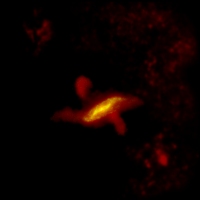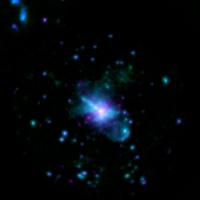Centaurus A's far-reaching jets
The Centaurus A galaxy, also known as NGC 5128, is the closest giant elliptical galaxy containing a radio-loud Active Galactic Nucleus (AGN). At a distance of only about 12 million light years, Centaurus A is an ideal test bed for investigating the physical processes taking place in active galaxies, allowing astronomers to spatially resolve details that are much harder to detect in more distant sources.
When viewed at optical wavelengths, Centaurus A exhibits the morphology of an elliptical galaxy with a spheroidal halo of stars; in addition, a prominent dark lane appears to cross the halo at these wavelengths. Observations in the infrared portion of the electromagnetic spectrum allow astronomers to peer through this obscuring lane and to reveal its structure by detecting the glow of cold dust within it. Moreover, due to the AGN activity of Centaurus A, powerful jets of highly energetic particles stream from the core of the galaxy, where a supermassive black hole accretes matter at a tremendous rate. As electrons in the jets emit synchrotron radiation, the jets shine brightly in X-rays as well as at sub-millimetre and radio wavelengths. Multi-wavelength observations of Centaurus A allow astronomers to develop a comprehensive view of how the various components of this fascinating galaxy interact with one another on different scales.
 |
|
Herschel image of Centaurus A. |
The image obtained with ESA's Herschel Space Observatory combines data acquired with the PACS instrument at far-infrared wavelengths (shown in yellow) and with the SPIRE instrument at sub-millimetre wavelengths (shown in red), respectively.
The central region, mostly evident in the PACS data, highlights the warped appearance of the galaxy's disc, which consists of a number of inclined, concentric rings of gas and dust and extends up to several thousand light-years from the galaxy's centre. While only a trace component in terms of mass, cold dust shines brightly at far-infrared and sub-millimetre wavelengths and can be used to trace the disc's structure. The curious shape of the disc suggests that it is the remnant of a merger that the galaxy has undergone with a smaller, gas-rich galaxy; this merger is also believed to be responsible for having triggered the AGN activity observed in Centaurus A.
Farther away, data from SPIRE reveal a glow that extends beyond the disc and traces the two jets that stem from the galaxy's centre in opposite directions. Although emission seen by the SPIRE instrument is most often associated with thermal emission from cold dust, in this case the synchrotron emission from the jets is so strong that it is readily detected by the instrument, and dominates the emission, as shown in the image.
The SPIRE data also reveal dust emission from two clouds at the galaxy's outskirts, towards the lower-right and upper-left corners of the image. These clouds are part of a ring of gas and dust that surrounds the galaxy, but elsewhere in the ring, the dust is too tenuous to detect. In spite of the alignment between these components of the galaxy, it is unlikely that the jets are responsible for heating the dust in the clouds, as the dust would soon disintegrate under the intense power of the jet. Most likely, dust in both clouds is being heated by radiation from Centaurus A's old population of stars.
The Herschel data also show that the amount of gas and dust in the diffuse medium around Centaurus A is larger than in other elliptical galaxies. This effect can be explained as another legacy of the past merger that took place, between Centaurus A and a smaller galaxy with a richer content in gas and dust.
 |
|
XMM-Newton image of Centaurus A. Credit: ESA/XMM-Newton |
The jets and their interaction with other components of the galaxy are also visible in the image of Centaurus A obtained with the EPIC camera on board ESA's XMM-Newton X-ray Observatory.
The X-ray image reveals emission coming from the active nucleus, at the centre of the image, and from the jets and lobes made up of highly energetic particles emanating from it. A number of foreground point-like sources are also visible, scattered across the image: these are X-ray binaries belonging to our Galaxy, the Milky Way. The X-ray emission from the core of Centaurus A is mainly produced by the material accreted by the central black hole. In addition, the inner part of the two jets that stem from the accretion disc also contribute to the central X-ray source, although they are not resolved in this image.
Further away from the centre of the image, two X-ray bright structures are visible: a filament extending to the upper left side of the galaxy's core and a faint lobe bounded by an arc-shaped region to its lower right. Both structures are believed to consist of gas from the galaxy's interstellar medium that has been heated to very high temperatures while interacting with the jet.
As the outflowing material in the jets and lobes expands supersonically, it gives rise to shocks that contribute to heating up the surrounding gas and cause it to emit X-rays. The interaction between these components is clearly visible in the composite image combining Herschel and XMM-Newton data, where the brightest X-ray emitting regions at the outskirts of Centaurus A coincide closely with the edges of the jets seen at sub-millimetre wavelengths.
| Fast Facts | |
| Depicted object: | Centaurus A (NGC 5128) |
| Additional details: | Early-type, AGN-hosting galaxy |
| Distance: | 12 million light years |
| Image Orientation: | North is up, East to the left |
| Far-infrared and sub-millimetre image | |
| Satellite: | Herschel |
| Instruments: | PACS; SPIRE |
| Wavelengths: | 100 micron (PACS; yellow); 250-350-500 micron (SPIRE; red) |
| Field of view: | 15 arc minutes x 15 arc minutes |
| Observation dates: | 27 December 2009; 02 January 2010 |
| Release date: | 4 April 2012 |
| Credit: | ESA/Herschel/PACS/SPIRE/C.D. Wilson, McMaster University, Hamilton, Ontario, Canada |
| Acknowledgements: | Very Nearby Galaxy Survey Key Programme |
| Related publications: | Auld, R., et al., 2012, MNRAS; Parkin, T., et al., 2012, MNRAS |
| X-ray image | |
| Satellite: | XMM-Newton |
| Instruments: | EPIC camera |
| Wavelengths: | 3.1-7.7 Ångström (1.60-4 keV; purple); 7.7-17 Ångström (0.75-1.60 keV; blue); 17-25 Ångström (0.50-0.75 keV; cyan) |
| Field of view: | 15 arc minutes × 15 arc minutes |
| Observation dates: | 02 February 2001; 06 February 2002; 02 February 2006; 15 July 2009; 20 and 22 August 2010 |
| Release date: | 4 April 2012 |
| Credit: | ESA/XMM-Newton |
| Related publications: | Kraft, R. P., et al., 2009, ApJ; Evans, D. A., et al., 2004, ApJ; Kraft, R. P., et al., 2003, ApJ |
| Visible image | |
| Observatory: | MPG/ESO 2.2-metre Telescope at La Silla Observatory, Chile |
| Instruments: | WFI |
| Wavelengths: | 456 nm (blue channel); 540 nm (green channel); 784 nm (red channel) |
| Credit: | ESO |
Related publications
Auld, R., et al., 2012, MNRAS, 420, 1882; DOI: 10.1111/j.1365-2966.2011.19819.x
Parkin, T., et al., 2012, MNRAS, in press; DOI: 10.1111/j.1365-2966.2012.20778.x
Kraft, R. P., et al., 2009, ApJ, 698, 2036; DOI: 10.1088/0004-637X/698/2/2036
Evans, D. A., et al., 2004, ApJ, 612, 786; DOI: 10.1086/422806
Kraft, R. P., et al., 2003, ApJ, 592, 129; DOI: 10.1086/375533
Contacts
Göran Pilbratt
ESA Herschel Project Scientist
Directorate of Science and Robotic Exploration
ESA, The Netherlands
Email: gpilbratt rssd.esa.int
rssd.esa.int
Phone: +31 71 565 3621
Norbert Schartel
ESA XMM-Newton Project Scientist
Directorate of Science and Robotic Exploration
ESA, Spain
Email: Norbert.Schartel esa.int
esa.int
Phone: +34 91 8131 184

